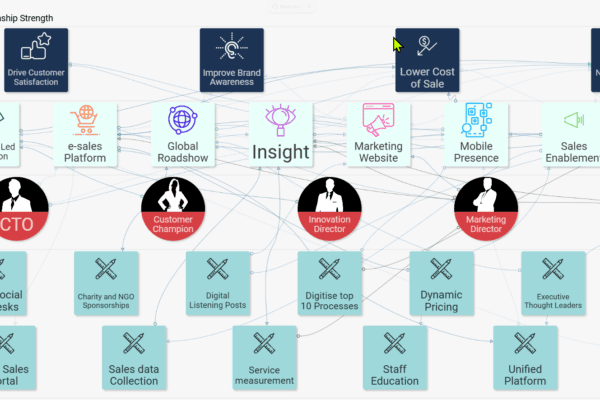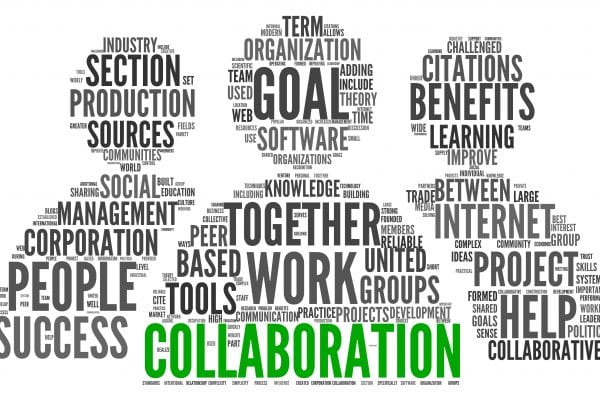With hybrid working now accepted, making your business collaboration work effectively is no longer an option.
So what are the problems and challenges you face with implementing hybrid working in your business and how can an effective business collaboration strategy help you overcome them?

Hybrid Working
I am sure you are familiar with the word collaboration, especially since you have probably had to start working remotely or connect with people who are working from home or in the office (hybrid working).
This hybrid way of working (office and remote) is not new, people worked out on project sites away from their office before the COVID 19 pandemic. When I was a consultant there was one time where it was nearly a year before I came back to the office, I was just out at client sites all around the world.
But times have changed, whereby there are a lot more people working remotely especially people in functions, teams and departments who traditionally would have worked from the office, such as Management, HR, Sales and Marketing, Finance, etc.
At the start and during the pandemic, what I noticed and heard from customers and other colleagues was the necessity to get staff “connected” online as quickly as possible so that business could continue. As a minimum this included being able to talk and see one another, share presentations, review documents and meet with clients and suppliers.
Since then the novelty of online calls, working remotely at home in isolation has worn off. There is certainly a desire to “meet up” and “catch up” with people, me included! People also realise hybrid working (office and remote) is here to stay but the ability to complete work activities and collaborate with other people needs to be improved.
How we work has changed
The workplace and how we conduct work has changed. As a business you will need to change too and adapt to this new way of working. Simply installing a digital collaboration tool e.g. Zoom or MS Team, is only the start. There is a lot more to consider.
An integrated collaboration approach is required that joins your physical and digital way of working, with yours and other businesses data. This integrated collaboration needs to be co-created and implemented only where it adds value. You could include it as part of your “digital transformation strategy” if you have one or have a collaboration strategy, that provides a roadmap of how to implement this collaborative way of working successfully.
Below are some insights with to remote working patterns, the advantages and disadvantages completed by Londonresearch.com, in 2020 “Remote Working Report”.
Remote Working
- 36% or respondents say they are more productive working from home compared to 27% who say they are less so.
- Over half (56%) say they had to change their working hours as a result of working home,
- The most common change to people’s working hours is to start earlier and finish later, with more time off during the day (31%).
Advantages of remote working
- The single biggest perceived benefit of remote working is the reduction in commuting time, seen as an advantage by nearly all respondents (95%).
- Linked to this is an improved balance between work and personal life, which more than four fifths said was an advantage (86%).
- Getting away from the distractions of the office and being focussed were seen as an advantage by over two-thirds of people.
Disadvantages and difficulties
- The biggest problem faced in remote working us reduced communication with colleagues, a major disadvantage for 72% of respondents.
- Linked to this , the feeling of isolation was the most significant challenge to respondents’ physical or mental health, cited by 75%.
Different types of collaborations
Collaboration is not just about video conferencing, using MS Teams, WebEx, Zoom and the like. There are different types of collaborations which by themselves are very important and play an important role within your overall business collaboration.
First do you recognise that there are different types of collaboration for you to consider? Where and at what level do these collaborations take place within your business? Are your collaborations aligned to your business vision, mission and strategy? Have you evaluated the differences and impact between physical collaboration, and digital, online collaboration in your business and how it could help overall performance?
Here are some key points for you to consider about collaboration, completed by a variety of organisations during 2019 and 2020.
- Collaborations can drive 10% productivity improvements. (Forrester, 2020)
- Employees could save 5-10% of their time, around two to four hours in a 40-hour week. (Forrester, 2020)
- 86% of business owners and staff attribute workplace problems to inadequate or poor communication tools. (Stone, 2019)
- Promoting effective team building and collaboration is the highest-ranked aspect of a great workplace. It was chosen by 43% of respondents in a survey. The next ranked aspect is health and well-being support at 36%. (Gensler, 2019)
- It was found that of collaboration software users, 85% are more likely to identify as being happy (Wrike, 2019)
- Communication tools (74%), remote work tools (74%), and collaboration tools (67%) are the most likely to be cited as important prerequisites for employees to be efficient. (Harvard Business Review, 2020)
- In fact, more than 75% of Millennials believe that a work-from-anywhere setup or remote work is an important company policy.(Klaxoon, 2020)
- When workers collaborate, 73% do better work, 60% are more innovative, 56% feel more satisfied, and 15% work faster. (Deloitte)
- Most companies need their behaviours, attitudes, and perceptions regarding the use of company-wide collaboration tools improved. Around 75% of executives state that their business functions compete instead of collaborating on their digital projects. As a result, 64% are not seeing a boost in their revenue growth from their digital investments. (Help Net Security, 2020)
- 91% of Gen Zers state that technical sophistication affects their interest in working in a company (McKinsey)
- For a 100-employee strong company with a 1:1 ratio of knowledge workers and frontline workers with hourly salaries of $60 and $40 respectively, using collaboration tools can help reach up to $247, 500 in productivity benefits. (Forrester, 2020)
So what are these different types of business collaborations and do you need them all?
Business Collaboration
Broadly there are 4 different types of collaborations that you undertake in your business and with other organisations. The fourth one is a result of the first three and these are:
- Physical collaboration
- Data collaboration
- Digital collaboration
- Visual collaboration

Physical collaboration
We all know good teamwork, people behaviours, creating positive and mutually beneficial business relationships, leadership, alignment are important for business success. However, putting this into action within your business and working jointly and collaboratively with other organisations can be very challenging.
One of the ways for you to get started is to complete an initial visual collaboration gap analysis. Using the ISO 44001 collaboration standard you can complete an initial gap analysis to help you to understand where you are currently in terms of collaboration capability, processes and systems.
Typically, the outcome from completing the gap analysis is to develop a collaboration roadmap along with the benefits (draft business case) to confirm whether working collaboratively is going to be of benefit for you and your business. Sometimes working in a transactional way is good enough and you don’t need to consider investing in collaborative working or may only require certain elements. That is one of the main benefits that I like about the ISO 44001 standard is that it is a framework, which you can adjust to your business.
Here is a definition of physical collaboration, which is focussed on the relationships of people and organisations:
Creating collaborative business relationships by committed organisations to maximise joint performance for achievement of mutual objectives and creation of additional value
Data collaboration
Data is an intangible business asset, you can’t pick it up and hold it. It needs to be “converted ” into something that you can see and understand.
Furthermore, there is a lot of it! I am sure you are constantly being bombarded with an ever increasing volume of data. Not always good data either! Poor quality, inaccurate, late/out of date data is very dangerous, especially if it being used to make critical business decisions. As a process control engineer I have seen the consequences of poor process data. Within a business context not only does it adversely impact your decision making, those bad decisions will have a negative impact on your business relationships internally with colleagues and external business partners.
Being able to share good quality data in a common data environment (CDE) and use it in various systems and IT applications can deliver information and insights that are not possible when the data is “siloed” Being able to interface to and upload data from other Line of Business Systems into a CDE, data warehouse, data lake and visualise it so that people can understand and act on it, is now a necessity for businesses to operate successfully. It is also a key component of your business collaboration.
Data collaboration is about visualizing data from all your different data sources, and getting this data to the right people, in the right format, in time to use it, so that they can make informed business decisions.
Digital collaboration
Where as physical collaboration focusses on peoples behaviours, culture, the relationships and direct interaction, digital collaboration enables this interaction to happen at a much larger scale and geographical spread, albeit its not a level where you can maintain a highly, social relationship. According to the “Dunbar’s number” this is around 150 people.
There are so many digital collaboration tools and apps to choose from. Below are examples of digital collaboration tool types.
- Code Collaboration
- Design Collaboration
- Document Collaboration
- Issue Tracking
- File Hosting
- Mail communication
- Note taking
- Project Management
- Productivity
- Product Management
- Scheduling
- Team Chat
- Vide Communication
- Time tracking
- etc.
Selecting the right ones is very challenging as there are multiple overlaps of functionality and capability. Creating your collaboration requirements will help you differentiate between different technologies and their ability to support your business. Here are five other factors you need to consider from Michael Samson “Collaboration Roadmap”:
- Viability of the vendor
- Financial cost of the product over time
- Capabilities of the product
- Business partner and support channels
- Alignment with your other IT strategies and digital transformation programme
Digital collaboration is using digital technologies for collaboration. Dramatically different from traditional collaboration, it connects a broader network of participants who can accomplish much more than they would on their own.
Visual collaboration
Typically the term “visual collaboration” is used in the video conferencing sector to enable audio-video communications to facilitate meetings without travelling. I always thought it was more than this and after reading a paper “Visual Collaboration – Driving Business Efficiency Into the Next Millennium” by Andrew W. Davies of Wainhouse Research in June 1999 I knew I was right after reading the first paragraph of the Executive Summary.
It stated that visual collaboration “is much more“. It went on to say “It is the combination of audio and video and data in both real-time and store-and-forward applications. Visual collaboration enables people who are seperated by distance and time to work together across LAN and WAN connections to create value for their organisations. Visual collaboration is about marketing, selling, communicating and training. It’s not just about meetings anymore.”
So what type of online business collaborations do you have? Are they still just meetings or do you truly collaborate and complete work?
Yes it did go into the techy infrastructure detail but it highlighted that it “can shorten communication paths, speed decision making, improve teamwork, cut product development cycles, improve relationships with customers and key suppliers“. I am sure these are some or all benefits you want in your business.
The challenge is how and what do you need to do?
Visual collaboration includes the integration of your physical, data and digital collaborations to create hybrid business relationships that enable you to work productively with other people and organisations, share and visualise data in a secure, interactive and dynamic way using office digital tools, which improve communication, innovation and co-creates new and mutually beneficial value.
Below is a definition that incorporates all of the three previous collaborations:
“Visual collaborations are hybrid business relationships formed by committed organisations, who consistently create and share accurate, quality data to maximise joint performance for the achievement of mutual objectives, outcomes and creation of additional value”
Integrated Business Collaboration Model
Now that you have an understanding of each collaborations, the following integrated business collaboration model can be applied both within your business and with your external business partners. Between each collaboration type there needs to be appropriate integration. By integrating physical, data and digital collaboration you create your overall business visual collaboration solution. Although the model below are shown as symmetrical circles, the scope and degree of each collaboration will vary depending on your business model, complexity and the amount of hybrid collaboration with colleagues and business partners.
The integrated collaboration model is an iterative and continuous improvement process in terms of your business (organisation, people, business processes and systems) and has to adapt to the ongoing changes, both internally and externally.
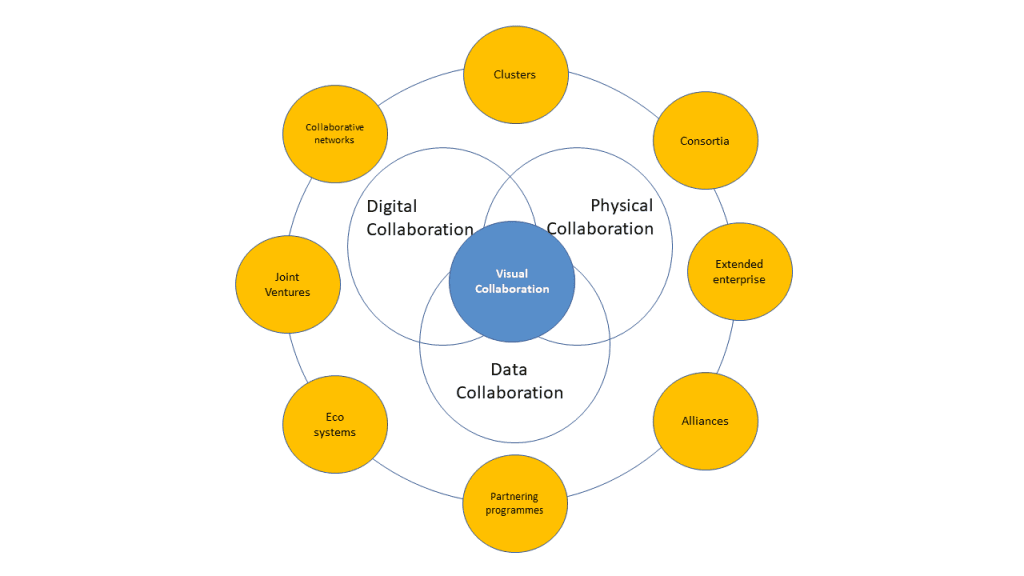
Integrated Business Collaboration Model
Integrating Your Business Collaborations
Between each of the three foundational collaborations; physical, data and digital there is a degree of integration between each of them. It is important to identify what these are and why you need them. Following on from that is the “where”, “when”, “who” and “how” you implement these collaborative integrations both physically (relationships, behaviours, teamwork, culture) and digitally (Data connectors/API’s/networks). This applies to your business which may have multiple locations and to your external business partners who may exist in different organisational structures and entities as shown in the outer yellow circles.
Below is summary of these three key interfaces and what you need to consider to ensure your collaborations are “joined up” sufficiently so that there are no gaps, unnecessary overlaps and or duplications.
Physical and Data Collaboration
People work with other people and use computers, laptops and mobile devices to create and enter data as part of this collaborative interaction. Creating a data culture within your business is critical, as data is one of your most valuable and under utilised business assets. Because there is so much data it is seen as a “commodity” and is not managed, governed and valued appropriately. As a result you end up with poor quality data – where by “garbage in is garbage out”. This is a problem that cannot be ignored.
Another way to think about data is that it is like fuel that you put into your car. Data drives business systems and applications. If you do not manage it, its like putting diesel fuel into a petrol car – it just will not work and cause severe damage!
Just think about the decisions you make using data with regards to your business relationships with customers and supply chain partners, your sales and marketing, innovation, services and products you provide, to delivering projects and programmes. They all need to have accurate data and information to operate correctly and deliver successfully.
If people do not trust the data that immediately puts a big block in the way to any successful collaboration and business success with your colleagues and business partners . Creating the right collaboration culture includes helping people to understand the value of data and how it can be used to make their job easier, more productive and mutually beneficial for all stakeholders, including you.
Not only do you have to trust people, you have to trust the data and your digital partners to work and make decisions with confidence.

Data Governance Is a Very Big Problem
Data culture and governance are certainly one of the top business collaboration challenges that I face, when working with customers to visualise their data as part of a business visual collaboration solution.
Having people who do not understand, do not take care or time to ensure that the data they create and enter into a “system” is of good quality and accurate, will cause you so many problems, resulting in:
- Misinformation
- Incorrect decision making
- System failure
- Incomplete information
- Inaccurate, wrong information
- Lack of trust
- System rejection – people stop using your IT system(s)
When visualising your data you need to ensure you are seeing consistent, standardised data attributes “apples for apples” and not “apples, pears and oranges”.
Consistent, standardised and agreed data
The fact that you and people in your business use computers every day to complete work, you need to ensure you are using data in a consistent, standardised and agreed way.
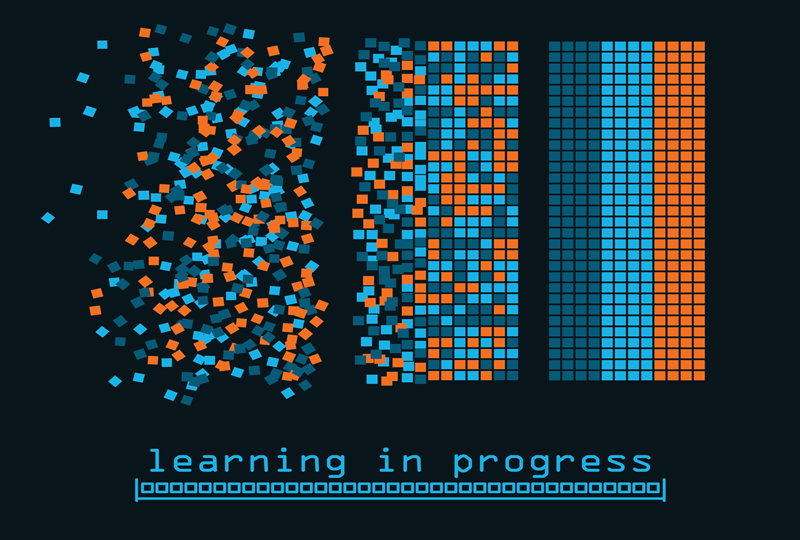
For example, I help many clients with implementing Project and Portfolio Management solutions, using our product R-PPM, powered by SharpCloud which has a standard meta data template to work from.
One of the first exercises is to look at the data sets that are currently being used, to establish the terms, phrases, naming conventions and structure of their data, including their units of measure, prefixes/suffixes, descriptions, where it is used and owner of the data. I am sure it is no surprise to you that there are usually multiple discrepancies, gaps and different naming conventions for the same data type. For example “plan” versus “schedule”; or writing complete whole numbers for costs where others abbreviate using a “k” or “M” or even “B”.
This becomes even more of a challenge when working with external business partners, who have their own systems and data structures.
Addressing data governance so you have an agreed and standardised way of managing it, as well as making it part of your collaborative working and culture, will help you to reduce this issue.
Data and Digital Collaboration
Over the last 30 years I have used process and business automation, IT systems and applications to help improve performance, productivity and collaboration, so that businesses can deliver their strategic objectives and outcomes successfully.
Making sure that the interaction between people and your various IT and Line of Business Systems is managed and governed appropriately, so that data is entered and created correctly, is so important as discussed previously. However, a common challenge is how to visualise and interact with this data.
Visualising Your Data
Now that you have this good quality data in your various Line of Business Systems (LoBS), you now need to visualise your data and put it to work.
Within the LoBS this is usually okay, as it will typically have various dashboards, reports and screens that visualise this data into meaningful information. But if you need to share with other people who do not have access to the LoBS, or you need to join different data sets from multiple LoBS, spreadsheets or other data sources into one place so that it can be easily shared, communicated and collaborated with, that’s when it becomes more challenging.
Moving on from spreadsheets, presentations and emails
If you are like a lot of businesses, you are probably using spreadsheets to collate and analyse your data, presentations to show and communicate this data and email to share and distribute with other people and businesses.
The use of these “productivity” tools provides flexibility, they are relative easy to use and can be configured to create simple to sophisticated, bespoke solutions. Furthermore, they are readily available to use along with a large user base to support and help.
As a result, people and businesses rely on their “mountain” of spreadsheets, presentations and emails, using tools such as Microsoft Excel, PowerPoint and Outlook, to run and operate their business. This typically includes capturing data, analysing it, creating graphs and tables and then copying and pasting it into a presentation and emailing it, to share and communicate with their “audiences”.
This type of work is “filling in the gaps” between your people, business processes, and “connecting” your data and workplace silos. Before the widespread availability and use of data and digital collaboration tools, I use to call this the 3P solution:
- People
- “Post It” notes and
- Paper
The issue is what happens when the data changes or what if there is a question but no slide to answer it. Ensuring you are using the right version of the “truth”, maintaining the calculations or ensuring you have updated the correct slides or you have copied everyone in (or not) becomes very complicated, time consuming and costly.
Your business collaboration process is delayed at best and completely stalled at worst. In terms of productivity this repetitive “wash, rinse and repeat” process is not acceptable and certainly acts as a blocker to your collaboration.
It is time for you to move on from this manual way of extracting, loading and transposing data from your LoBS, into a static view that has to be manually shared and is out of date as soon as you click “Send!”
There are several data visualisation tools such as Spotfire, Tableau, Microsoft Power BI, SharpCloud and many others for you to consider, but do they address your digital collaborations as well?

Data visualisation, integration and automation
Over the many projects that I have completed, invariably there needs to be a business case to justify the investment of the business change, technology, integration and automation.
One of the workshops I complete is a Makigami workshop. This looks at end-to-end processes, just like “the wash, rinse and repeat” process I mentioned above and how it can be simplified, focussing on removing the “7 deadly sins of loss”
In one project we saved over 212 days per annum by eliminating non -added value administration tasks such as manual copying, pasting, collating and comping data to produce static reports that had a shelf life of a about 2 days.
This is a key opportunity for you to reduce costs, improve efficiency and increase performance by integrating your data collaboration with your digital tools. Identifying a tool or platform that covers both areas helps to simplify your collaboration systems and processes, as well reduce training, support and operational costs.
As mentioned earlier, you need to clearly define your collaboration requirements, aligned to the benefits and outcomes you need to deliver as stated within your business strategy. There are several tools you can use as referenced above, which I have used. Some are excellent at the data visualisation, such as Tableau and Power BI.
However, it’s not just about dashboards. You need to create interactive, dynamic and data driven views that can deliver a wide variety of user cases/solutions such as:
- Project Portfolio Management
- Strategy and Technology Roadmaps
- Risk Management
- Collaboration Hub and Relationship Management
- Innovation Management
- Digital Workshops – SWOT, PESTLE, Gap Analysis, etc.
- Communications and Presentations
- Dashboards
Being able to deploy and integrate these solutions at a tactical, operational, strategic and enterprise level (with other business partners), is a key enabler to hybrid collaboration.
It also needs to be flexible like your spreadsheets and presentations, easy to use yet provide the necessary data governance and enterprise scalability to collaborate internally and externally.
This is where a no code/ low code visual collaboration platform like SharpCloud should be considered.
This type of visual collaboration platform provides you the ability to integrate and visualise your data to create data driven views which can be dynamically interacted and added to, by people working from multiple locations and in other organisations.
Digital and Physical Collaboration
Now you need to connect your digital and physical collaborations to complete the loop.
In your physical collaboration you have developed the right collaboration behaviours and incorporated a data culture to ensure accurate data is created and entered into your business IT systems.
Your data collaboration has integrated various LoBS data sets both internally and with your external business partners so you can visualise it in data driven views.
Finally, your digital collaboration tools facilitates sharing and interaction of your data with other people and enables you to do more with it – adding and creating more value.
However, it is all very well getting digital data being displayed in a dashboard or report but sometimes it needs to be put into context.
What do I mean by “putting it into context”?
Putting your digital information into context
For example if you have a data driven view of your Project Portfolio, which is showing the risk status of your projects in a Probability and Impact Diagram (PID) using a 5 x 5 matrix, you may have a project which has a 5 probability and a 5 impact score (Red x Red). But what does that mean, what is the mitigation plan, when will it be mitigated?
This is when you need to be able to take peoples knowledge, their years of experience and add it to the digital data and information to put it into context.
Yes we now have Artificial Intelligence (AI) and Machine Learning (ML) to help us, but taking an experienced Project Managers view and adding it to the data makes it more meaningful, especially if it is addressing the performance of other people, how they are feeling, performing or responding.

Knowledge sharing
A typical approach that you can take with your digital data is “management by exception”.
This is being able to focus in on items with in seconds by visually seeing the issue(s). Using our example above – projects that have a high risk would be shown in the top right hand quadrant of our 5 x 5 matrix, coloured red, so you can hone in on them quickly.
What I have noticed without exception, is that people want to read the commentary to help put these items/projects into context, especially if there are several high risk items/projects. And, where appropriate provide feedback, insight or simply offer support or a “helping hand” i the form of group or direct commentary.
Its not all about dealing with issues or problems. Being able to read and understand why something has worked well and being able to contact that person, have a video call or meet directly facilitates knowledge sharing and collaborative networking.
Collaborative behaviours
Whether you are meeting online digitally or physically, coaching and developing people’s collaboration behaviours is very important.
This is where completing a collaboration capability internal gap assessment of the people in your business will help you, and needs to include both the physical and digital aspects.
This will help when you cannot pick up on the visual cues you normally get when working directly with another person, when using digital tools such:
- Instant messaging
- Video Conferencing
- Content Sharing
- Co-Authoring
Levels of Collaboration
Now that you have an integrated business collaboration model, including an overview of the interfaces between each of these collaborations, you now need to determine where in your business they need to be applied.
There are three levels of collaboration within your business.
- Strategic
- Operational
- Tactical
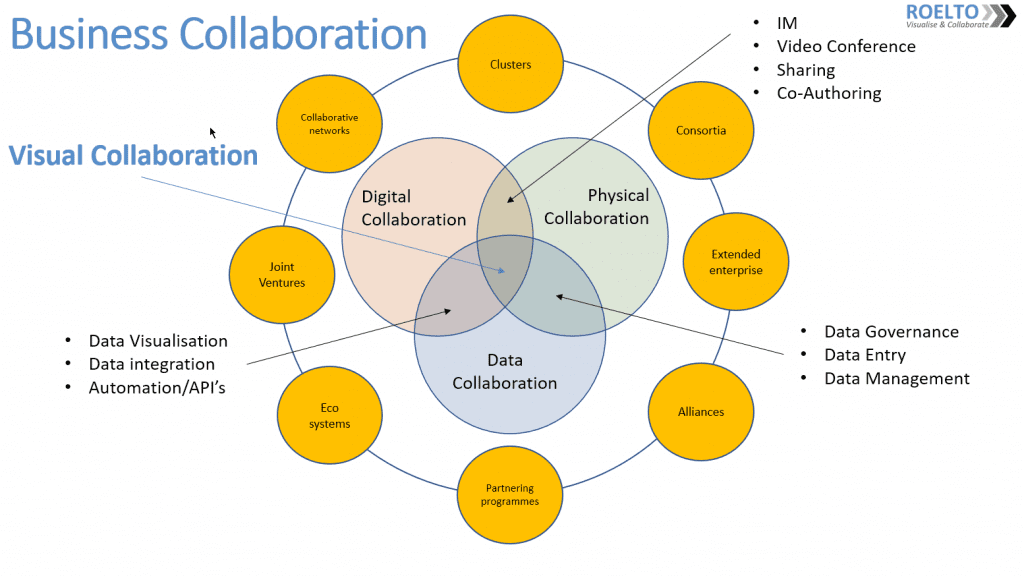
Strategic collaboration
Collaboration is not a quick fix way of working. It takes time, a lot of effort and cost to successfully embed within your business and with your selected business partners. Strategic collaboration is considered at business organisation level and working with other external organisations. Assessing where you can harness the benefits of collaborative working is part of your strategic assessment including:
- the needs and expectations of stakeholders
- scope of your business collaboration
- the systems and processes required
- determining and defining the new opportunities and value created
Operational collaboration
Once you have decided that you are going to adopt collaborative working within your business, you need to be able to operationalise it so that it can be consistently applied. Integrating collaborative working appropriately with your current quality management systems, training and development programmes, recruitment, internal management processes and systems will help you to embed collaboration within your business.
Other areas to consider will be leadership, actions to address risks and opportunities, support and the development of a business collaboration plan that captures, defines and integrates with existing business management and operational processes and procedures.
Tactical collaboration
Using your collaboration plan you can start to work jointly with other people and organisations to help co-create new ideas, opportunities and value by completing mutually agreed and defined actions. This can cover a wide spectrum of activities depending on the size and complexity of the collaborative project and number of relationships/stakeholders involved.
Below are list of typical tactical collaboration activities you could complete with colleagues or your selected business partner(s):
- Joint Collaboration Charter
- Collaboration business case (benefits)
- Stakeholder management
- Alignment of interests
- Partner evaluation and selection
- Organisation roles and responsibilities
- Performance Management – joint outcomes
- Joint ways of working
- Communications
- Continuous improvement and KPI’s
- Exit strategy
The challenge is how to develop and complete these tasks so that they can be consistently applied across your business and shared with potential business partners. This can be done by incorporating them into your collaboration strategy and referencing the resources, tools and templates on how to complete them.
ISO 44001 Collaboration Framework
The ISO 44001 collaborative business relationship management systems – requirements and framework can be used to help you define your strategic, operational and tactical collaborations. The model below illustrates the 8 stages within the Operation section of the specification. The 8 stages can be applied to your physical, data and digital collaborations as appropriate.
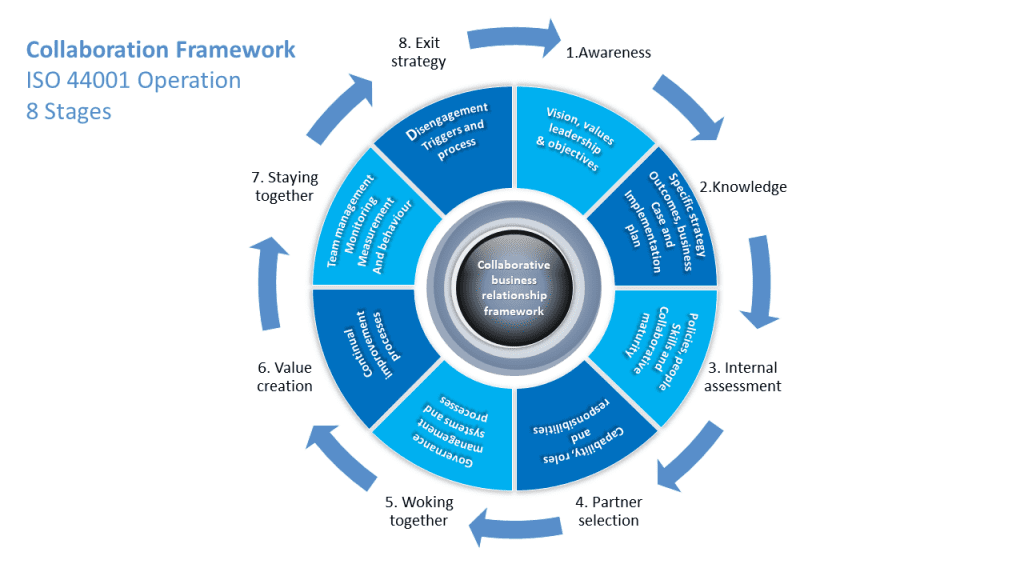
How to apply successful collaboration within your business
The simple model below represents the 4 key parts of your business:
- Organisation – Leadership, Culture, Teamwork and Alignment
- People – Behaviours, Skills, Values and Knowledge
- Processes – Operations, Customer, Innovation, Regulatory and Social
- Systems – Databases, Systems, Applications, Networks
Within your business you will have a Vision, Mission and Strategy that identifies your Strategic Objectives and Outcomes. Your collaborations need to be aligned to both your strategic objectives and outcomes so that it enables and facilitates in helping you to deliver your mission and vision successfully.
If it doesn’t then you should either stop or change accordingly.
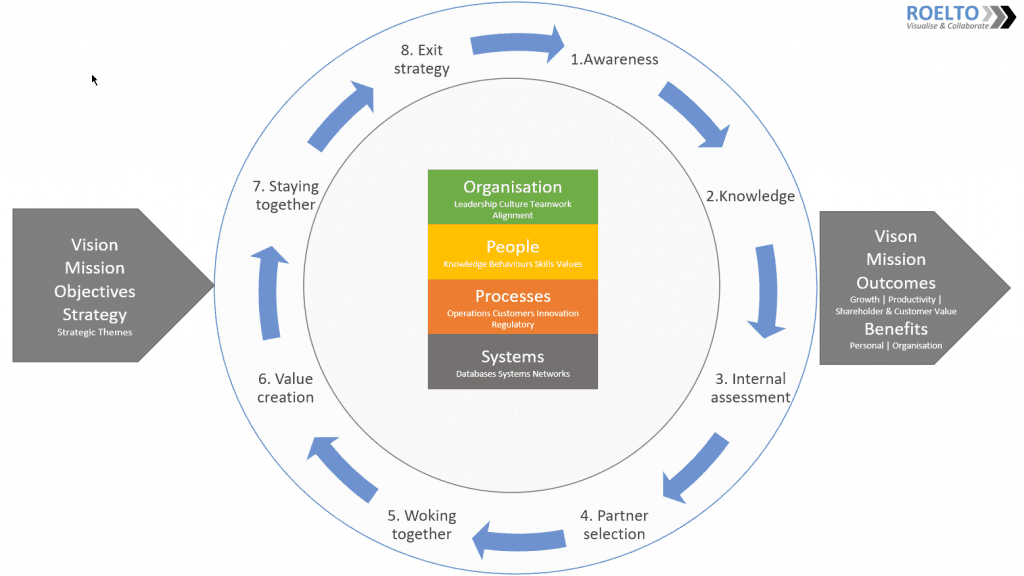
Roelto Integrated Visual Collaboration Approach (RIVCA)
Collaboration Types + Collaboration Integration + Levels of Collaboration + ISO 44001 Collaboration Framework = RIVCA, supporting hybrid working
Roelto Integrated Visual Collaboration Approach (RIVCA) aligns, integrates and embeds your collaborations with a focus on data visualisation into an approach you can easily use and apply in your business and with your partners.
This approach helps you to develop a hybrid working, high performing and learning organisation through the creation and use of, your data, information and knowledge. This applies to other businesses that you decide to partner and work jointly with. Significantly increasing your innovation capacity and capability to create new value.
How you align, integrate, embed and use visual collaboration within your business will determine how well you will be able to visually collaborate internally and externally with other people and businesses.
Below is the Roelto Integrated Visual Collaboration Approach, which brings all of the elements that I have shared with you together, to help you support and deliver your hybrid way of working successfully.
Your business (organisation, people, process & systems) is supported by your collaborations, at all levels within your business, using a standardised collaboration framework to co-create a continuous flow of data, information and knowledge, both internally and externally with business partners.
Furthermore, this approach aligns with your business strategic objectives and outcomes and will realign as your business adapts to market changes and your hybrid business relationships.
R-CaaS App, powered by SharpCloud
Hybrid working and collaborating with other people is not new.
However, the importance of collaboration and its different parts has become a major issue for businesses to address since hybrid working has become the norm for more businesses.
To help support this, Roelto Collaboration-as-a-Service App (R-CaaS), powered by SharpCloud based on the ISO 44001 Collaboration Framework can support your business and project collaborations.
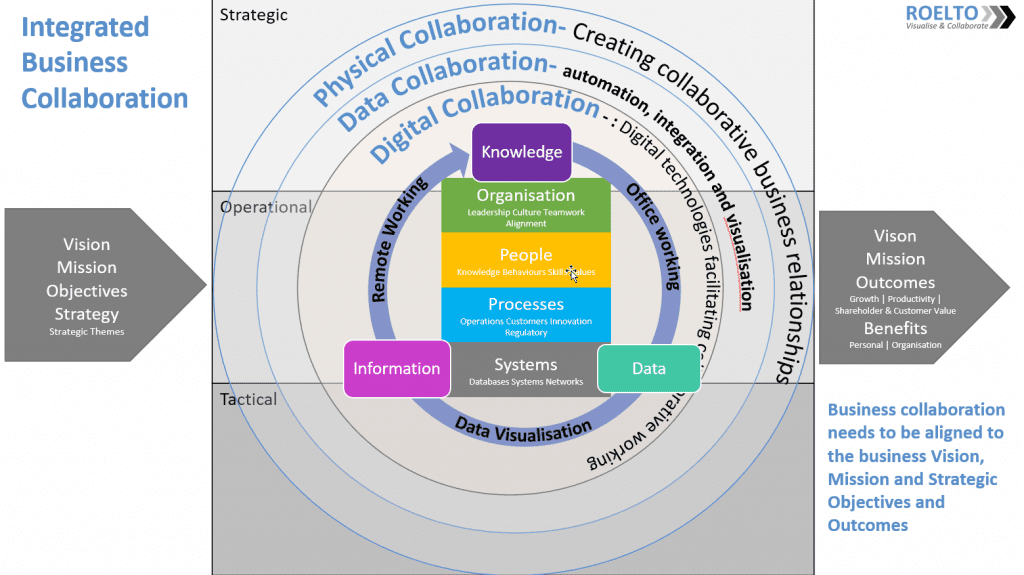
Roelto Integrated Visual Collaboration Approach (RIVCA) supports hybrid working
Visual Collaboration 10 Steps
To implement an integrated visual collaboration approach with you business, here are the 10 iterative steps that you need to complete. You do this first within your business to establish your “corporate collaboration strategy” and then with the business partners you have selected to work collaboratively with:
- Step 1: Utilising Visual Collaboration
- Step 2: Understand Your Full Potential
- Step 3: Create Your Knowledgebase
- Step 4: Play To Your Strengths
- Step 5: Apply the 80/20 Principle
- Step 6: Utilise Your Assets
- Step7: Become More Innovative
- Step8: Sustain High Levels of Teamwork
- Step 9: Ensure Future Business Continuity
- Step 10: Managing Your Visual Collaboration
Collaboration Strategy
Completing the above steps will deliver you your business collaboration strategy (refereed as the Relationship Management Plan in ISO 44001), which as stated previously, can be used internally and externally with your business partners.
Importantly you need to ensure you maintain and improve your collaboration through review and assessment by completing the following:
- Your organisation – assess where you are able to harness the benefits of collaborative working
- Leadership – ensure your leadership team are demonstrating leadership, commitment and accountability
- Planning – make sure you keep track of the issues and requirements and determine the risks and opportunities you need to address
- Resources – verify what resources are required to deliver your collaborations
- Measure – put in place a monitoring and measuring process/system to analyse your performance and results
- Improvement – ensure you apply a continuous improvement mind set to address issues promptly and improve your hybrid business collaborations
Start Your Hybrid Working Journey
Getting started is always a challenge.
However, one way to start is to join one of our Visual Collaboration Seminars or complete your initial visual collaboration gap analysis or do both!
Click on the Green and Orange buttons below to join the next seminar and get your free Visual Collaboration Gap Analysis.

